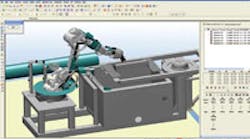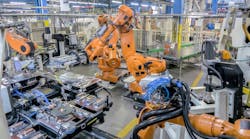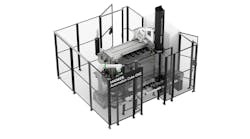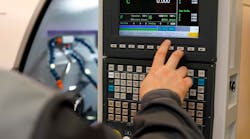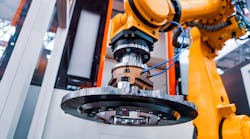Shops can spend days programming a robot’s moves. Now, a new release of Robotmaster CAD/CAM software eliminates having to use the “teach” method to program a robot and shortens the teaching process considerably.
“What once took days, is done in hours,” Greg Culp of In-House Solutions (www.inhousesolutions.com), said. Culp is a Robotmaster representative.
Robotmaster was designed to integrate robot programming, simulation and code generation seamlessly inside Mastercam software. It’s a two-software, off-line approach.
Shops have to program toolpaths for manufacturing with Mastercam Mill or Router. Then, they add their robot as a Mastercam machine group through the extensive configuration library in the Robotmaster program.
Shops use the software’s graphical interface to fine-tune the parameters by which Robotmaster will translate the 2-axis to 5-axis CNC toolpath data into a 6-axis robot toolpath. Once that is done, the Robotmaster’s simulator validates and optimizes the program. The software’s postprocessor then generates the robotready program file.
The Robotmaster program was designed for applications such as mold machining, polishing, spray coating, welding, grinding, dispensing, painting, de-flashing and de-burring, and trimming. Two companies that currently use the Robotmaster software are Flow International (www.flowcorp.com) and Weber Aircraft LP (www.weberair.com).
Through Robotmaster, Flow’s Applications Group said it improved the efficiency of robots that it pairs with its ultrahigh-pressure waterjet cutting systems. Flow supplies the waterject cutting systems to Tier One automotive manufacturers and other users.
Its 6-axis robot waterjet systems perform trimming operations on such components as floor carpeting, door panels and instrument panels.
Duane Snider, sales and applications engineer with the Flow Applications Group, said programming robots off line is one of the biggest benefits of Robotmaster.
“We’ve built systems with four robots working on one part. The pain point is when you have to stop production of work cells, using four employees to re-program four robots, or one employee to juggle four robots. This is high-production capital equipment that should be up and running and making money for the company,” Snider said.
He said that off-line programming allows operators to start a new program in seconds. By changing the tools or fixtures when that is required, then downloading a pre-set program from the main computer, operators and machines can remain in production.
Robotmaster’s trajectory pathrich environment gives the necessary information to the machine, allowing the robot to make quick changes in motion. Unlike standard teachbased robotic software that can be cumbersome to program and adapt, CAD/CAM-based Robotmaster allows the operator to modify the trajectory based on the path the robot must follow. For some applications at Flow, this ability has reduced programming that took a full day down to 15 minutes.
Off-line programming with Robotmaster opens the door to highprecision manufacturing.
Being able to track a robot’s path and motion enhances accuracy, and off-line programming is versatile, allowing CNC machines and other automated tools to go where they have never gone before, such as performing trimming operations. For those applications, robots can replace expensive router machines.
That is what happened at Weber Aircraft, a maker of commercial aircraft seats.
Weber Aircraft needed to increase production capacity for plastic food trays for commercial aircraft seats and didn’t want to purchase a second 5-axis routing machine, so it solicited the help of the Texas Manufacturing Assistance Center (TMAC) and the Automation & Robotics Research Institute (ARRI) at the University of Texas.
For Weber, ARRI selected a Staubli Rx90 robot for the trimming application and added Mastercam and Robotmaster to take programming off-line and save production time.
The system reduced cycle times by 23 percent, saved floor space, improved cut quality and precision, decreased programming time, and made the trimming process safer and cleaner.
